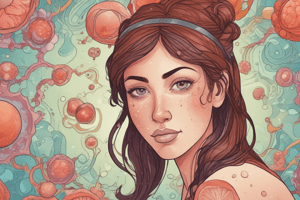Podcast
Questions and Answers
What is the mechanism of action of Cromolyn Sodium aka Sodium Cromoglycate?
What is the mechanism of action of Cromolyn Sodium aka Sodium Cromoglycate?
- Release of histamine through degranulation of mast cell
- Inhibit the production of histamine in the body
- Prevent release of histamine through degranulation of mast cell (correct)
- Stimulate release of acetylcholine to counteract histamine
Which of the following antihistamines has the highest potential for CNS stimulation and medium potential for epigastric distress?
Which of the following antihistamines has the highest potential for CNS stimulation and medium potential for epigastric distress?
- Chlorpheniramine (correct)
- Diphenhydramine
- Dimenhydrinate
- Promethazine
What is the indication for using Cromolyn Sodium in allergic conjunctivitis?
What is the indication for using Cromolyn Sodium in allergic conjunctivitis?
- Prophylactic treatment to prevent allergic reactions (correct)
- Symptomatic relief of allergic conjunctivitis
- Treatment of acute allergic reactions
- Treatment of non-allergic conjunctivitis
Which of the following is a side effect of ethanolamine antihistamines?
Which of the following is a side effect of ethanolamine antihistamines?
What is the classification of Hydroxyzine among antihistamines?
What is the classification of Hydroxyzine among antihistamines?
What is the difference between first-generation and second-generation antihistamines?
What is the difference between first-generation and second-generation antihistamines?
What is the brand name of Cromolyn Sodium used to treat food allergies?
What is the brand name of Cromolyn Sodium used to treat food allergies?
Which of the following is NOT an indication for the use of Cromolyn Sodium?
Which of the following is NOT an indication for the use of Cromolyn Sodium?
What is the primary mechanism of action of antihistamines?
What is the primary mechanism of action of antihistamines?
What is a common vascular effect of histamine?
What is a common vascular effect of histamine?
Which of the following is a potential side effect of antihistamine use?
Which of the following is a potential side effect of antihistamine use?
What is an indication for the use of antihistamines?
What is an indication for the use of antihistamines?
Which of the following medications may interact with antihistamines?
Which of the following medications may interact with antihistamines?
What is the term for a severe, life-threatening allergic reaction?
What is the term for a severe, life-threatening allergic reaction?
What is the primary effect of histamine on smooth muscle?
What is the primary effect of histamine on smooth muscle?
What is a common use of antihistamines in addition to allergy treatment?
What is a common use of antihistamines in addition to allergy treatment?
What is the effect of histamine on capillaries?
What is the effect of histamine on capillaries?
What is a common side effect of 1st generation antihistamines?
What is a common side effect of 1st generation antihistamines?
What is an indication for antihistamine use?
What is an indication for antihistamine use?
What is a potential drug interaction with antihistamines?
What is a potential drug interaction with antihistamines?
What is an advantage of 2nd generation antihistamines?
What is an advantage of 2nd generation antihistamines?
What is a less common side effect of antihistamines?
What is a less common side effect of antihistamines?
What is a cardiac effect of histamine?
What is a cardiac effect of histamine?
What is a unique feature of 2nd generation antihistamines?
What is a unique feature of 2nd generation antihistamines?
Flashcards are hidden until you start studying
Study Notes
Allergens and Antigens
- Allergen: a substance that can trigger an allergic reaction
- Antigen: a substance that can trigger an immune response, including an allergic reaction
- Antibody: a protein produced by the immune system to fight an antigen
Types of Allergic Reactions
- Rhinitis: an allergic reaction that affects the nose, resulting in sneezing, runny nose, and itchy eyes
- Erythema: a skin reaction characterized by redness and itching
- Dermatitis: a skin reaction characterized by redness, itching, and inflammation
- Urticaria: a skin reaction characterized by itchy hives
- Anaphylaxis: a severe, life-threatening allergic reaction that can cause difficulty breathing, rapid heartbeat, and a drop in blood pressure
Action of Histamine
- Vascular Effects:
- Dilation of capillaries, leading to transient hypotension
- Leaky capillaries, causing fluid and protein leakage, leading to irritation of nasal membranes or hives
- Extravascular Smooth Muscle:
- Contraction of smooth muscles, leading to intestinal or bronchial constriction
- Cardiac Effects:
- Rapid heartbeat
- Possibly leading to arrhythmias at high levels
Indications for Antihistamines
- Acute allergic reactions:
- Hay fever
- Insect bites
- Pet dander
- Minor food/drug allergies
- Rhinitis
- Dermatitis
- Itchy eyes
- Scratchy throat
- Urticaria
- Dry nasal secretions (anticholinergic component)
- Sleep aids (due to sedative properties)
- Reduction of nausea and vomiting (including motion sickness)
First Generation Antihistamines
- Sedation is greatly increased when taken with:
- Hypnotics
- Sedatives
- Anxiolytics
- Alcohol
- Narcotic analgesics
- Muscle relaxants
- Other CNS depressants
Advantages of 2nd Generation Antihistamines
- More selective for peripheral H1-receptors
- Less sedating
- Less drying
- May be useful for patients refractory to older agents
- Longer half-life, may be dosed once daily
Side Effects of Antihistamines
- More Common SE’s:
- Drowsiness and sedation
- Dry mouth (xerostomia)
- Dry mucous membranes
- Less Common SE’s (typically only seen in overdose):
- Hypotension
- Urinary retention
- Rapid heartbeat (tachycardia)
- Epigastric distress
Antihistamine Groups
- 1st Generation:
- Ethanolamines (most sedating, highest anticholinergic effects)
- Alkylamines (highest potential for CNS stimulation, medium for epigastric distress)
- Phenothiazines (high anticholinergic effects, moderate sedation)
- Other first generation (hydroxyzine, very sedating)
- 2nd Generation:
- Cetrizine
- Fexofenadine
- Loratidine
- Desloratidine
Antiallergic Agents
- Cromolyn Sodium (Sodium Cromoglycate):
- Mechanism of Action: prevents release of histamine through degranulation of mast cell
- Preventative strategy only
- Indications: chronic bronchial asthma, allergic rhinitis, food allergies, and allergic conjunctivitis
Studying That Suits You
Use AI to generate personalized quizzes and flashcards to suit your learning preferences.




